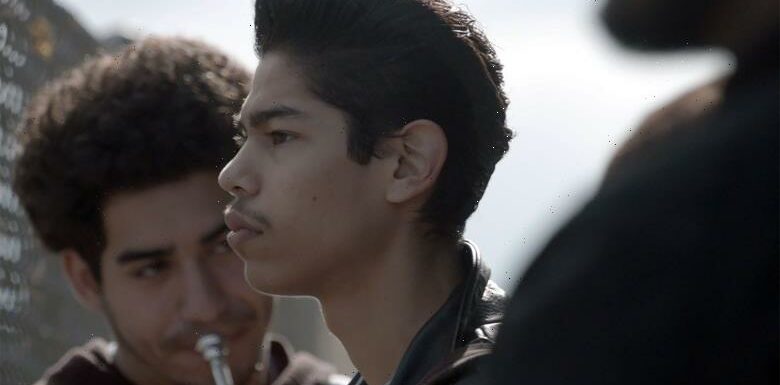
The captions that appear throughout “The Tuba Thieves” are generous, imaginative, and expansive, giving names to sounds we’re familiar with but have likely never thought to put into words. The sound of ocean waves is described as a “rush and fall.” A mop very specifically “smacks the floor” in the distance. Even when there’s no detectible sound, captions indicate that “air circulates.”
First-time filmmaker (and seasoned visual artist) Alison O’Daniel, who is hard of hearing, offers captions that are tactile, existing in a place beyond pure sound. In doing this, she de-prioritizes hearing audiences, asking them to tune into her work in novel and often confounding ways. At the same time, she centers her film around various iterations of non-verbal communication and the generative experiment of attempting to describe sounds the way d/Deaf or hard-of-hearing people might conceive of them.
This project avoids easy categorization or description, falling somewhere between documentary and fiction, with dozens of narrative threads that weave in and out of the film’s framework before ambiguously fading out completely. Organized informally around a mysterious series of tuba thefts that took place in Southern California high schools between 2011-2013, this work is interested in examining the presence and absence of sound itself. O’Daniel is curious about what it means to remove a sound from its typical position at the forefront of our cinematic experience — as well as what happens when you eliminate the tuba’s thumping heartbeat from a high school marching band.
But to piece together any kind of definitive plot or greater meaning beyond this goes against O’Daniel’s intentions.“The Tuba Thieves” is about embracing uncertainty and misunderstanding — something d/Deaf/hard-of-hearing people do every day. In fact, the film’s entire genesis was intended as a large-scale “game of telephone,” deliberately seeking out disorder and unexpected end products.
O’Daniel began her ambitious endeavor by giving non-sound–based references to Deaf artist and performer Christine Sun Kim, hearing painter and musician Steve Roden and the late hearing composer Ethan Frederick Greene. One score was prompted by “the path the Zamboni makes to clear away the snow and lay a fresh sheet of ice,” according to a Creative Capital talk O’Daniel gave in 2019. Another was inspired by a fan letter a physicist wrote to Tarkovsky after seeing his film “Mirror.” The artists then composed music that would give rise to her screenplay. O’Daniel has been exhibiting parts of the film at galleries and museums since 2015 alongside sculptural works referencing the same non-verbal prompts and has now assembled all the segments into a feature film.
The unconventional process of constructing “The Tuba Thieves” seems to have contributed to the film’s disjointed, often frustratingly incomprehensible structure. Running parallel to the story of the tuba thieves is the very loose narrative of a deaf drummer (Nyke Prince), her boyfriend (Russell Harvard), and father (Warren “Wawa” Snipe) and how they relate to the music, sounds, and ambient noises of Los Angeles. In addition, O’Daniel explores three historic concerts that embraced silence in various forms: The 1952 premiere of John Cage’s 4′33″, in which a pianist sits at their piano in silence for four minutes and 33 seconds; a 1979 punk show at the Deaf Club in San Francisco; and Prince’s surprise visit to the Deaf University Gallaudet during his 1984 “Purple Rain” tour.
It may sound like a lot to process, but the trick is to simply let “The Tuba Thieves” happen and relax into its languid rhythm, essentially free of spoken language. Anyone hoping to find out who was behind the tuba thefts or how Nyke’s story ends will be disappointed. It can be difficult to stay engaged, especially since O’Daniel doesn’t spend enough time with any particular character long enough to let us connect with them.
She is less concerned with people and more with sound, particularly as a phenomenon that disconnects and misconstrues meaning rather than as a force that unifies. This can make it challenging for hearing audiences, who are accustomed to deciphering narrative meaning from the alchemy of sound and vision. But those who are open to a little bit of disorientation will experience an invigorating break from our habitual ways of hearing, inspired by the experiences of people with a wholly different, and perhaps more creative, relationship to sound.
Together with editor Zack Khalil and director of photography Derek Howard, both accomplished experimental filmmakers in their own rights, O’Daniel brings to life a synesthetic space in which plants whisper and hum to each other, where the air above a forest fire vibrates and where one man’s ASL sign for “sunrise” is infinitely more expressive than the English word alone. She asks hearing audiences to sit in their discomfort and, in doing so, bear witness to the unique, valuable, and imaginative world of the d/Deaf and hard-of-hearing community.
Grade: B+
“The Tuba Thieves” premiered at the 2023 Sundance Film Festival. It is currently seeking U.S. distribution.
Source: Read Full Article